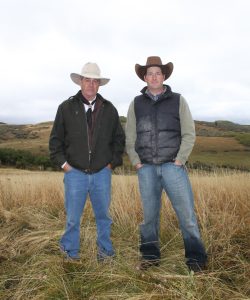AB Direct - Steers
Rail: 495.00-500.00
AB Direct - Heifers
Rail: 495.00-500.00
US Trade- Steers
Rail: 370.00-372.00 (NE/IA) Thursday
US Trade - Heifers
Rail: 370.00-372.00 (NE/IA) Thursday
Canadian Dollar
0.14

Writing a legacy of sustainable ranching
Revisiting the 2015 Environmental Stewardship Award recipient,
Bar S Ranch
Every beef operation in Alberta has a story worth telling. When the Chattaway family of Bar S Ranch shares their story, it speaks to four generations of ranchers protecting the land that sustains their cattle and livelihood.
This dedication earned the ranch, located west of Nanton, Alberta and run by Clay Chattaway and his sons Morgan and Scott, the 2015 Environmental Stewardship Award (ESA).
“Sustainability to us is being able to carry on what we’ve always done and being able to add more,” said Morgan after the family received the provincial award.

The ESA program celebrates beef producers who stand out for their commitment to environmental stewardship. Presented annually by ABP, nominees are assessed on their sustainability practices in areas such as animal welfare, water quality, land management, wildlife, and stewardship-related leadership activities.
Situated at the headwaters of Mosquito Creek in the picturesque Porcupine Hills, the Bar S Ranch is a cow-calf and yearling operation comprised of about 20,000 acres of deeded and lease land.
“My grandfather came in 1900 and ranched about five miles north, and in 1919 he bought a good part of what’s known as the Bar S today,” said Clay, who took over running the ranch from his parents in the 1970s.
“The best part about ranching is the family aspect and watching subsequent generations come in. The whole family is part of the management team.”
Together, the Chattaways give their best to this ranch. The foundation of their sustainability practices, as Clay described in 2015, is “to leave the land in better shape than we received it, and we received it in pretty good shape.”
Finding success with tried-and-true practices
The Chattaways manage their operation with careful attention to the natural resources available, working to get the most from the land while enhancing it.
“Our stewardship goals are just managing the grass in a way that our cattle improve, in a way that the grass improves, and in a way that our streams stay healthy,” said Morgan, noting that they’ve used most of their sustainability practices for decades.
With their location in the foothills and an elevation range of 1,000 feet across the ranch, their cattle graze in the high country during the warmer seasons, returning to lower ground in winter. Shares in the Waldron Ranch Grazing Co-op supplement their pastureland. Their rotational grazing system, with cattle moved every three to four days, allows the herd to graze year-round, with feeding generally only needed prior to calving. To better fit this approach, the Chattaways moved their calving season to May about two decades ago, missing the worst of the spring blizzards and taking advantage of the amount of grass available to meet nutritional requirements.
Their use of electric fencing supports rotational grazing, creating three times the number of paddocks on the Bar S than prior to implementing this system. Their cattle are split into five herds, with about 15 paddocks allotted to each herd. This provides more than enough recovery time for the grass and the opportunity to graze some paddocks a few times throughout the year. It also leaves sufficient forage and cover for the wildlife found on the ranch, which includes deer, moose, elk, wolves, black bears, grizzly bears, and cougars.
For simple, year-round access to clean water, the Chattaways have used gravity fed watering systems to develop springs around the ranch, which run continuously and won’t freeze in cold temperatures.
Receiving the ESA for the values that are steeped into their ranch’s history was a special honour for this family, who are writing the future by sharing these practices with the next generation.
“Winning the stewardship award feels good, and it’s nice to be recognized by your peers,” said Morgan.
“The best part about living here and working here is you get to spend time with your family, you get to be outdoors and you get to work with cattle and with wildlife.”
Nominations for the 2023 ESA are now open!
You could be the next producer to share your sustainability story through the ESA program.
The deadline for nominations is March 15, 2023* at 11:59 p.m.
This article was first published in Volume 3 Issue 1 of ABP Magazine (February 2023). Watch for more digital content from the magazine on ABP Daily.
*Editor’s Note: The deadline for this year’s nominations was extended from February 28 to March 15, 2023.

